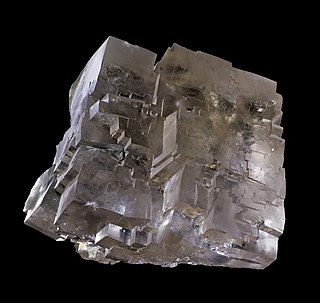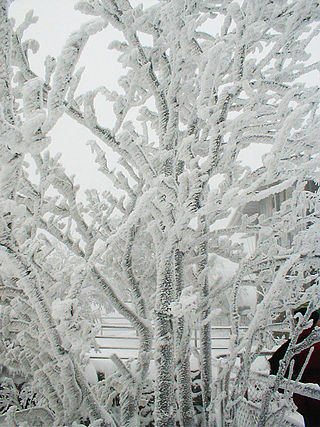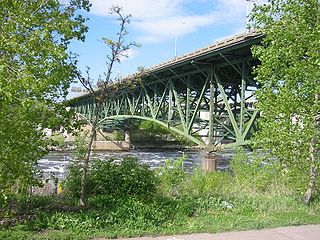
Frost is a thin layer of ice on a solid surface, which forms from water vapor that deposits onto a freezing surface. Frost forms when the air contains more water vapor than it can normally hold at a specific temperature. The process is similar to the formation of dew, except it occurs below the freezing point of water typically without crossing through a liquid state.

Ice is water that is frozen into a solid state, typically forming at or below temperatures of 0 °C, 32 °F, or 273.15 K. It occurs naturally on Earth, on other planets, in Oort cloud objects, and as interstellar ice. As a naturally occurring crystalline inorganic solid with an ordered structure, ice is considered to be a mineral. Depending on the presence of impurities such as particles of soil or bubbles of air, it can appear transparent or a more or less opaque bluish-white color.

Snow comprises individual ice crystals that grow while suspended in the atmosphere—usually within clouds—and then fall, accumulating on the ground where they undergo further changes. It consists of frozen crystalline water throughout its life cycle, starting when, under suitable conditions, the ice crystals form in the atmosphere, increase to millimeter size, precipitate and accumulate on surfaces, then metamorphose in place, and ultimately melt, slide or sublimate away.

Sodium chloride, commonly known as edible salt, is an ionic compound with the chemical formula NaCl, representing a 1:1 ratio of sodium and chlorine ions. It is transparent or translucent, brittle, hygroscopic, and occurs as the mineral halite. In its edible form, it is commonly used as a condiment and food preservative. Large quantities of sodium chloride are used in many industrial processes, and it is a major source of sodium and chlorine compounds used as feedstocks for further chemical syntheses. Another major application of sodium chloride is deicing of roadways in sub-freezing weather.
Freezing rain is rain maintained at temperatures below freezing by the ambient air mass that causes freezing on contact with surfaces. Unlike a mixture of rain and snow or ice pellets, freezing rain is made entirely of liquid droplets. The raindrops become supercooled while passing through a sub-freezing layer of air hundreds of meters above the ground, and then freeze upon impact with any surface they encounter, including the ground, trees, electrical wires, aircraft, and automobiles. The resulting ice, called glaze ice, can accumulate to a thickness of several centimeters and cover all exposed surfaces. The METAR code for freezing rain is FZRA.

Snow removal or snow clearing is the job of removing snow after a snowfall to make travel easier and safer. This is done both by individual households and by governments, institutions, and commercial businesses.

Deicing is the process of removing snow, ice or frost from a surface. Anti-icing is the application of chemicals that not only deice but also remain on a surface and continue to delay the reformation of ice for a certain period of time, or prevent adhesion of ice to make mechanical removal easier.

Rime ice forms when supercooled water droplets freeze onto surfaces. In the atmosphere, there are three basic types of rime ice:

The ice accretion indicator is an L-shaped piece of aluminium 38 cm (15 in) long by 4 to 5 cm wide. It is used to indicate the formation of ice, frost or the presence of freezing rain or freezing drizzle.

In aeronautics, icing is the formation of water ice on an aircraft. Icing has resulted in numerous fatal accidents in aviation history. Ice accretion and accumulation can affect the external surfaces of an aircraft – in which case it is referred to as airframe icing – or the engine, resulting in carburetor icing, air inlet icing or more generically engine icing. These phenomena may possibly but do not necessarily occur together.

Atmospheric icing occurs in the atmosphere when water droplets suspended in air freeze on objects they come in contact with. It is not the same as freezing rain, which is caused directly by precipitation.

Interstate 35W (I-35W), a north–south Interstate Highway, is the western half of I-35 where it splits to serve the Dallas–Fort Worth metropolitan area. I-35 splits into two branch routes, I-35W and I-35E, at Hillsboro. I-35W runs north for 85.2 miles (137.1 km), carrying its own separate sequence of exit numbers. It runs through Fort Worth before rejoining with I-35E to reform I-35 in Denton. It is the more direct route for long-distance expressway traffic, as is noted on signs on I-35 leading into the I-35W/I-35E splits. During the 1970s, billboards existed on I-35 encouraging travelers to take the faster and shorter I-35W route.

Anchor ice is defined by the World Meteorological Organization as "submerged ice attached or anchored to the bottom, irrespective of the nature of its formation". It may also be called bottom-fast ice. Anchor ice is most commonly observed in fast-flowing rivers during periods of extreme cold, at the mouths of rivers flowing into very cold seawater, in the shallow sub or intertidal during or after storms when the air temperature is below the freezing point of the water, and the subtidal in the Antarctic along ice shelves or near floating glacier tongues, and in shallow lakes.
In ground deicing of aircraft, aircraft deicing fluid (ADF), aircraft deicer and anti-icer fluid (ADAF) or aircraft anti-icing fluid (AAF) are commonly used for both commercial and general aviation. Environmental concerns include increased salinity of groundwater where de-icing fluids are discharged into soil, and toxicity to humans and other mammals.

The I-35W Mississippi River bridge was an eight-lane, steel truss arch bridge that carried Interstate 35W across the Mississippi River one-half mile downstream from the Saint Anthony Falls in Minneapolis, Minnesota, United States. The bridge opened in 1967, and was Minnesota's third busiest, carrying 140,000 vehicles daily. After only 39 years in service, it experienced a catastrophic failure during the evening rush hour on August 1, 2007, killing 13 people and injuring 145. The National Transportation Safety Board (NTSB) cited a design flaw as the likely cause of the collapse, noting that an excessively thin gusset plate ripped along a line of rivets. Additional weight on the bridge at the time of failure was also cited by the NTSB as a contributing factor.
Freezing drizzle is drizzle that freezes on contact with the ground or an object at or near the surface. Its METAR code is FZDZ.

A winter service vehicle (WSV), or snow removal vehicle, is a vehicle specially designed or adapted to clear thoroughfares of ice and snow. Winter service vehicles are usually based on a dump truck chassis, with adaptations allowing them to carry specially designed snow removal equipment. Many authorities also use smaller vehicles on sidewalks, footpaths, and cycleways. Road maintenance agencies and contractors in temperate or polar areas often own several winter service vehicles, using them to keep the roads clear of snow and ice and safe for driving during winter. Airports use winter service vehicles to keep both aircraft surfaces, and runways and taxiways free of snow and ice, which, besides endangering aircraft takeoff and landing, can interfere with the aerodynamics of the craft.

Graupel, also called soft hail or snow pellets, is precipitation that forms when supercooled water droplets in air are collected and freeze on falling snowflakes, forming 2–5 mm (0.08–0.20 in) balls of crisp, opaque rime.

Glaze or glaze ice, also called glazed frost or verglas, is a smooth, transparent and homogeneous ice coating occurring when freezing rain or drizzle hits a surface. It is similar in appearance to clear ice, which forms from supercooled water droplets. It is a relatively common occurrence in temperate climates in the winter when precipitation forms in warm air aloft and falls into below-freezing temperature at the surface.
Freezing or frost occurs when the air temperature falls below the freezing point of water. This is usually measured at the height of 1.2 metres above the ground surface.




















